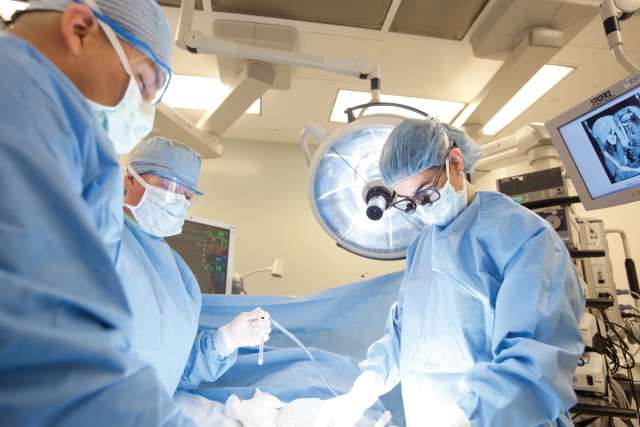UCLA Health offers patients with Parkinson’s disease access to the latest treatment innovations and clinical trials for potential disease-modifying therapies. The benefits to patients include better symptom management and better quality of life, says Danielle Thordarson, MD, assistant clinical professor of neurology at the David Geffen School of Medicine at UCLA.
“New symptomatic treatment approaches, ranging from oral medications and delivery systems to deep brain stimulation (DBS) technologies, address the problem of motor fluctuations in Parkinson’s disease,” Dr. Thordarson says.
The mainstay of therapy is levodopa, effectively supplementing back the dopamine that is deficient in Parkinson’s disease. Levodopa enables normal movements – treating tremor, slowness, stiffness, walking problems and often non-motor symptoms as well.
One of the challenges in treatment is that levodopa typically works well at the beginning of the disease. “But with time, it’s difficult to maintain the drug at a therapeutic level in a patient’s system throughout the day, causing a waning benefit,” says Dr. Thordarson.
“However, new oral therapies, including longer-acting formulations of levodopa, achieve smoother drug levels all day, with less frequent dosing. And new adjunct agents enhance the effect of levodopa by targeting additional pathways.”
A new delivery system, the foscarbidopa-foslevodopa subcutaneous pump, was studied at UCLA and approved in October 2024. It provides continuous subcutaneous delivery of levodopa and overcomes the challenges of motor fluctuations and off periods that can occur with traditional oral formulations, notes Dr. Thordarson.
Advances in DBS
Deep brain stimulation has been available for people with Parkinson’s disease for several years; however, advancements in the technology has opened the door to treatment improvements.
“We now have modern DBS systems that offer directional leads, allowing stimulation to be steered toward specific brain areas, enhancing precision and minimizing unwanted side effects,” says Dr. Thordarson. “More recently, these systems have evolved to include sensing capabilities, meaning they are equipped with electrodes that act like a microphone to listen to brain signals in real time.”
Certain brain signals correlate with certain symptoms in Parkinson’s disease. “This information helps us find a precise ‘sweet spot’ – how much and where to stimulate in the brain to achieve the best symptomatic control,” explains Dr. Thordarson. “Tremors, rigidity, slowness all can be helped.”
The systems currently in use are paving the way for the next iteration of DBS: adaptive deep brain stimulation. “It is still under development, but we expect it will be coming very soon,” notes Dr. Thordarson. “Once approved, adaptive DBS will use real-time feedback from brain signals to adjust stimulation dynamically, based on a patient’s needs, to optimize symptom control.”
Biomarkers
CLIA-approved biomarker tests, such as alpha-synuclein skin biopsies and cerebral spinal fluid assays have helped clinically reduce diagnostic uncertainty, “when we’re teasing out what the underpinnings of someone’s presentation mean,” says Dr. Thordarson.
How these biomarker tests should best be used remains an area of some debate among those in the field, she notes.
“Biomarkers are not part of the diagnostic criteria for Parkinson’s disease. But they provide additional supportive information to help us determine a diagnosis.”
Furthermore, biomarkers can help detect patients in the early stages of disease so that intervention can be deployed sooner. They are also powerful tools from a research standpoint, allowing clinicians to detect pathology early and define clinical trial populations, Dr. Thordarson says.
Genetic testing
Precision medicine for patients with Parkinson’s disease is an important outgrowth of UCLA’s innovative PDGENEration program, which provides free genetic testing for anyone diagnosed with Parkinson’s disease at any stage. The testing is done via a blood test at UCLA or a self-administered home test kit.
“Part of our PDGENEration program goal is to include diverse and underserved populations,” says Dr. Thordarson. “We hope to better understand the genetic underpinnings of Parkinson’s disease and identify patients with known genetic risk factors that might be amenable to precision-medicine approaches now in clinical trials.”
Genetic testing is helping tailor treatments to LRRK2- and GBA-associated Parkinson’s disease. Planning is underway for additional clinical trials in both subtypes.
Emerging approaches
Stem cells are an important potential treatment avenue and a powerful tool in research. The stem cells derived from patients and cultivated in the lab are being used to study Parkinson’s disease at a cellular level to understand disease development, which can vary widely in individual patients.
In clinical trials, stem cells are being surgically implanted into patients to replace the dopaminergic neurons that have been lost through Parkinson’s disease, says Dr. Thordarson. Early signs of safety and potential efficacy are being seen in studies, she adds.
As a national and global leader in research and treatment of Parkinson’s disease, UCLA Health offers patients access to subspecialty experts, Dr. Thordarson says, including in “difficult areas such as freezing of gait, advanced deep brain stimulation technologies and more.”
She adds, “That translates to a better quality of life, even for patients with advanced disease and motor fluctuations.”




